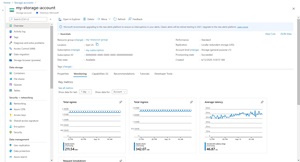Q&A
Navigating Cloudy Horizons with Azure Monitor and Application Insights
Azure Monitor is a comprehensive cloud-based service that allows users to collect, analyze, and act on telemetry data from various Azure resources, services and applications.
It's designed to be the single place for monitoring all your Azure Infrastructure-as-a-Service (IaaS) and Platform-as-a-Service (PaaS) services, plus your own applications and code while also being able to extend to on-premises resources as well as resources in other clouds.
"Azure Monitor is built on top of Log Analytics, the platform service that gathers log and metrics data from all your resources," explained Paul Schnackenburg in the Virtualization & Cloud Review article, "Azure Monitor 101," when it debuted. "Think about it like this -- Azure Monitor is the marketing name, while Log Analytics is the technology that powers it."
 [Click on image for larger view.] Overview Page (source: Microsoft).
[Click on image for larger view.] Overview Page (source: Microsoft).
It has come a long way since that 2021 debut and is now a well-rounded tool that provides visibility into the health, performance and availability of cloud resources, enabling proactive monitoring and troubleshooting for enhanced operational efficiency.
To keep up with the technology, David Giard, Sr. Technical Evangelist at Microsoft, will present a session at the upcoming Visual Studio Live! conference in Chicago titled Navigating Cloudy Horizons with Azure Monitor and Application Insights. In his 75-minute intermediate-level session on April 30 he will explain the concepts important to monitoring applications and how to configure Azure Monitor and Application Insights to collect relevant data, alert you when potential problems occur, and report on that data in near real time.
Specifically, after the session attendees are promised they will be able to:
- Understand Azure Monitoring
- Understand monitoring
- Use Application Insights
We caught up with Giard to learn more about his upcoming session in a short Q&A:
VisualStudioMagazine: What inspired you to present a session on this topic?
Giard: A partner requested guidance on how to implement an effective monitoring strategy, which forced me to learn the tooling in detail. I wanted to share what I learned with others.
Can you briefly elaborate on how Azure Monitoring differs from traditional monitoring solutions, and what unique advantages it offers for cloud-based applications?
Azure Monitoring is tightly integrated into Azure cloud services, providing near-real-time results.
 "Azure Monitoring is tightly integrated into Azure cloud services, providing near-real-time results."
"Azure Monitoring is tightly integrated into Azure cloud services, providing near-real-time results."
David Giard, Sr. Technical Evangelist, Microsoft
In your presentation, you emphasize the importance of monitoring applications. Could you briefly summarize list a few key concepts or best practices in application monitoring that are particularly relevant in today's cloud-centric environment?
- Measure the most critical metrics
- Periodically review what you are monitoring and adjust this over time
What are a couple challenges or pitfalls users face when configuring Azure Monitor and Application Insights?
One challenge is deciding what to monitor: too little and you may miss a trouble spot; too much and you may incur excessive overhead.
How does Azure Monitor enable proactive monitoring and troubleshooting?
You can schedule alerts to notify you if a metric is outside an acceptable range, so you can address it before a failure occurs.
How do the real-time reporting and alerting capabilities of Azure Monitor and Application Insights improve operational efficiency?
By tracking the performance and success of your cloud services, you can prevent errors before they occur and understand when a metric falls outside a "normal" range.
Note: Those wishing to attend the conference can save hundreds of dollars by registering early, according to the event's pricing page. "Register for VSLive! Chicago by the March 29 Early Bird deadline to save up to $300 and secure your seat for intensive developer training in Chicago!" said the organizer of the developer conference, which is presented by the parent company of Visual Studio Magazine.
About the Author
David Ramel is an editor and writer at Converge 360.